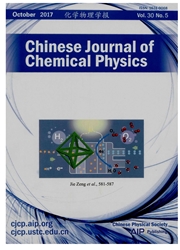

 中文摘要:
中文摘要:
利用基质隔离红外光谱结合理论计算,研究了激光溅射获得的第五族金属原子和硫化氢分子的反应.结果表明金属原子插入H2S的H-S化学键形成HMSH分子(M=V,Nb,Ta).对Nb和Ta该HMSH分子重排为H2MS分子.HMSH分子和H2S进一步反应生成H2M(SH)2分子.通过D2s和H234s同位素标定确定了产物的分子结构,同时我们用DFT(B3LYP和BPW91)理论计算预测了产物分子的能量、结构和振动频率.通过DFTIRC计算研究了第五族金属原子和2S分子的反应机理.HVSH分子通过光照解离为VS和H2,然后通过退火可以发生VS和H2复合反应.计算表明HVSH释放H2需要16,9kcal/mol的活化能及吸热13.5kcal/mol.
 英文摘要:
英文摘要:
The reaction of laser-ablated vanadium, niobium and tantalum atoms with hydrogen sulfide has been investigated using matrix isolation FTIR and theoretical calculations. The metal atoms inserted into the H-S bond of H2S to form the HMSH molecules (M=V, Nb, Ta), which rearranged to H2MS molecules on annealing for Nb and Ta. The HMSH molecule can also further react with another H2S to form the H2M(SH)2 molecules. These new molecules were identified on the basis of the D2S and H234S isotopic substitutions. DFT (B3LYP and BPW91) theoretical calculations are used to predict energies, geometries, and vibrational frequencies for these novel metal dihydrido complexes and molecules. Reaction mechanism for formation of group V dihydrido complex was investigated by DFT internal reaction coordinate calculations. The dissociation of HVSH gave VS+H2 on broad band irradiation and reverse reaction happened on annealing. Based on B3LYP calculation releasing hydrogen from HVSH is endothermic only by 13.5 kcal/mol with lower energy barrier of 16.9 kcal/mol.
 同期刊论文项目
同期刊论文项目
 同项目期刊论文
同项目期刊论文
 Combined Triple and Double Bonds to Uranium: The N U=N-H Uranimine Nitride Molecule Prepared in Soli
Combined Triple and Double Bonds to Uranium: The N U=N-H Uranimine Nitride Molecule Prepared in Soli The cobalt oxide/hydroxide nanowall array film prepared by pulsed laser deposition for supercapacito
The cobalt oxide/hydroxide nanowall array film prepared by pulsed laser deposition for supercapacito One-step preparation of single-crystalline Fe2O3 particles/graphene composite hydrogels as high perf
One-step preparation of single-crystalline Fe2O3 particles/graphene composite hydrogels as high perf Pulsed laser deposition of large-area manganese oxide nanosheet arrays for high-rate supercapacitors
Pulsed laser deposition of large-area manganese oxide nanosheet arrays for high-rate supercapacitors Detection and Electronic Structure of Naked Actinide Complexes: Rhombic-Ring (AnN)2 Molecules Stabil
Detection and Electronic Structure of Naked Actinide Complexes: Rhombic-Ring (AnN)2 Molecules Stabil Pulsed laser deposition of Ag nanoparticles on titanium hydroxide/oxide nanobelt arrays for highly s
Pulsed laser deposition of Ag nanoparticles on titanium hydroxide/oxide nanobelt arrays for highly s Reactions of Ti, Zr, and Hf Atoms with Hydrogen Sulfide: Argon Matrix Infrared Spectra and Theoretic
Reactions of Ti, Zr, and Hf Atoms with Hydrogen Sulfide: Argon Matrix Infrared Spectra and Theoretic Advanced asymmetric supercapacitors based on CNT@Ni(OH)(2) core-shell composites and 3D graphene net
Advanced asymmetric supercapacitors based on CNT@Ni(OH)(2) core-shell composites and 3D graphene net Tantalum atom reactions with ammonia: Matrix infrared spectra and DFT calculations of the H2TaNH and
Tantalum atom reactions with ammonia: Matrix infrared spectra and DFT calculations of the H2TaNH and Infrared Spectra and Quantum Chemical Calculations of the Bridge-Bonded HC(F)LnF(2) (Ln = La-Lu) Com
Infrared Spectra and Quantum Chemical Calculations of the Bridge-Bonded HC(F)LnF(2) (Ln = La-Lu) Com Matrix Infrared Spectroscopic and Computational Investigations of the Lanthanide-Methylene Complexes
Matrix Infrared Spectroscopic and Computational Investigations of the Lanthanide-Methylene Complexes Spectroscopic Observation of a Group 12 Oxyfluoride: A Matrix-Isolation and Quantum-Chemical Investi
Spectroscopic Observation of a Group 12 Oxyfluoride: A Matrix-Isolation and Quantum-Chemical Investi Infrared Spectra of IrCCH2, HIrCCH, and Ir-eta(2)-C2H2 Prepared in Reaction of Laser-Ablated Iridium
Infrared Spectra of IrCCH2, HIrCCH, and Ir-eta(2)-C2H2 Prepared in Reaction of Laser-Ablated Iridium OMS, OM(eta(2)-SO), and OM(eta(2)-SO)(eta(2)-SO2) Molecules (M = Ti, Zr, Hf): Infrared Spectra and D
OMS, OM(eta(2)-SO), and OM(eta(2)-SO)(eta(2)-SO2) Molecules (M = Ti, Zr, Hf): Infrared Spectra and D Integrating three-dimensional graphene/Fe3O4@C composite and mesoporous Co(OH)(2) nanosheets arrays/
Integrating three-dimensional graphene/Fe3O4@C composite and mesoporous Co(OH)(2) nanosheets arrays/ Pulsed laser deposited Ag nanoparticles on nickel hydroxide nanosheet arrays for highly sensitive su
Pulsed laser deposited Ag nanoparticles on nickel hydroxide nanosheet arrays for highly sensitive su The exceptions to the Walsh rules: Linear and cyclic structures of EX2 (E = C, Si, Ge, Sn, Pb and X=
The exceptions to the Walsh rules: Linear and cyclic structures of EX2 (E = C, Si, Ge, Sn, Pb and X= Co(OH)(2) Nanosheets Coupled With CNT Arrays Grown on Ni Mesh for High-Rate Asymmetric Supercapacito
Co(OH)(2) Nanosheets Coupled With CNT Arrays Grown on Ni Mesh for High-Rate Asymmetric Supercapacito A High Energy and Power Li-Ion Capacitor Based on a TiO2 Nanobelt Array Anode and a Graphene Hydroge
A High Energy and Power Li-Ion Capacitor Based on a TiO2 Nanobelt Array Anode and a Graphene Hydroge Asymmetric supercapacitors based on nano-architectured nickel oxide/graphene foam and hierarchical p
Asymmetric supercapacitors based on nano-architectured nickel oxide/graphene foam and hierarchical p One-step strategy to three-dimensional graphene/VO2 nanobelt composite hydrogels for high performanc
One-step strategy to three-dimensional graphene/VO2 nanobelt composite hydrogels for high performanc Growing Nickel Cobaltite Nanowires and Nanosheets on Carbon Cloth with Different Pseudocapacitive Pe
Growing Nickel Cobaltite Nanowires and Nanosheets on Carbon Cloth with Different Pseudocapacitive Pe 期刊信息
期刊信息
